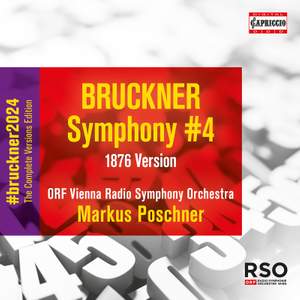
Anton Bruckner (1824-1896)
Symphony No 4 in E-flat major (1876) ‘Romantic’
ORF Vienna Radio Symphony Orchestra/Markus Poschner
rec. 2021, Radiokulturhaus, Vienna, Austria
Bruckner 2024 – The Complete Versions Edition
Capriccio C8084 [66]
In October 2021, I very favourably reviewed Jakub Hrůša’s survey of three versions of this symphony, including the one played here, and I refer you to that review and the previous review linked below for further background information, but in brief this is Prof. Benjamin Korstvedt’s 2021 edition of the original score rather than the more usually heard 1878/80 version in either the Haas or Nowak editions.
Comparison with that Hrůša recording is therefore in order for obvious reasons, and I must say that Hrůša’s slightly more measured tempo immediately makes Poschner sound a little perfunctory in the opening measures – and then the ensuing little tripping Gesangsperiode also sounds rushed. Poschner’s guiding principle is clearly that of generating as much excitement as possible; under him, the whole movement is three minutes faster than Hrůša’s. Its perkiness means that some of the potential lyricism of this music is missing; likewise, the chorale beginning at 3:25 is exciting but breathless, whereas Hrůša is much grander, and the conclusion is positively frenetic. I bemoaned this penchant for hurrying in my review of Poschner’s Third Symphony (review) yet I really liked – and recommended – his recording of the 1878/80 version in the same series (review). All this is a matter of taste, of course; you might prefer his more compact and incisive manner; I like to encounter more spaciousness in my Bruckner – and having said that, there is no lack of repose in the central section; both conductors find the right balance between the contrasting moods, even if I think Hrůša does it somewhat better.
The Andante is more conventionally paced but again less mysteriously hesitant than Hrůša, who better captures the “spookiness” of this music – nor is Poschner’s conclusion, while fine, as overwhelmingly majestic as Hrůša’s.
The original Scherzo is decidedly inferior to the ‘Hunt’ which replaced it. Poschner’s solution to “papering over the cracks” is to go faster than Hrůša in the two outer scherzo sections and once again, I find the latter more convincing. Haste does not necessarily generate tension. Hrůša’s Trio is more relaxed and bucolic, yet in the final reprise of the insistent, repetitive motif, he integrates the tacked-on coda after the surprising pause more effectively with a more dynamic – and dynamically varied – delivery.
Yet more of the same applies to the finale; there is a two-and-a-half-minute disparity of timings between the two recordings as Poschner typically hurries it. I remarked in my review how Hrůša essentially makes a virtue of the cruder aspects of the music, giving it a massive, granitic character, whereas Poschner pushes on. The Sibelian “whirlwind” passage five minutes in is more imposing – again, the dynamics are more tellingly graduated in Hrůša’s recording – but there is little to choose between their respective treatments of the triumphant conclusion. (Surely Howard Shore had it in mind when composing some of the more epic sections of his score for The Lord of the Rings films?)
The sound is first-rate – unimpeachable – and the presentation, notes by Paul Hawkshaw, Norbert Trawäger and Poschner himself, plus photographs, are of Capriccio’s usual high standard.
For all its virtues, this account is intermittently vitiated by Poschner’s tendency to apply fast speeds and I am quite sure that when I want to hear the original version of this symphony as edited by Prof. Korstvedt, I shall first reach for Hrůša and the Bambergers over this latest instalment of the Capriccio Bruckner 2024 project.
Ralph Moore
Previous review: Gregor Tassie
(This review posted here by kind permission of The Bruckner Journal.)
Help us financially by purchasing from




















